Locality
Arctic Slope of Alaska locality USGS 11606, north of Maybe Creek. This locality is a bluff approximately 10 m high on the east side of an unnamed tributary of the Price River. The predominant lithologies are bentonitic clays overlying a silty sandstone capped by coal beds up to 2 m thick, which are in turn overlain by a white-gray medium-grained sandstone. Irregularly dispersed throughout the clay are nodules and sheets of ferruginous limestone (sideritic) which, although light gray when fresh, weather to a rusty brown. With the exception of some poorly preserved plant matter in the upper sandstones, and impressions of platanoid leaves in the power sandtsones, the plant material is confined to these fine-grained iron-rich nodules and is preserved as impressions totally lacking cuticle. There is little evidence of post-mortem decay but many leaves are penetrated by vertical fossil rootlets. Platanoid leaves are most common in siltier/sandier facies. The uppermost coal surface supports several in situ tree bases each of which is approximately 20 cm in diameter.
Latitude: 69.528329 °N
Longitude: -153.887128 °W
Description
Leaf: simple; symmetrical; elliptic; apex obtuse; base missing; margin entire; venation pinnate; primary midvein moderate, straight; secondary veins moderate, markedly curved, angle of divergence from the midvein moderate acute (50°) more or less uniform along the length of the midvein but more acute at the base, festooned brochidodromous becoming almost eucamptodromous near base, loops joining the superadjacent secondary at an acute angle; intersecondary veins simple; tertiary veins percurrent, straight, sometimes forked, angle of divergence on admedial side of secondary veins acute or approximately 90°, on abmedial side more or less at right angles but sometimes acute or obtuse, relationship to the midvein variable from obtuse near the midvein to approximately right angles near the margin, forming loops at the margin; fourth order veins indistinct but reticulate and forming 3-5-sided well developed areoles with no obvious preferred orientation, ultimate marginal venation looped.
Remarks
Given the somewhat poorly organized venation this specimen compares well with those described by Bell (1963) from the Dunvegan Formation of British Columbia as 'Magnolia' rhamnoides (p. 43; Plate 23, Figs. 1, 4; Plate 24, Figs. 1-4).
